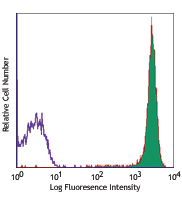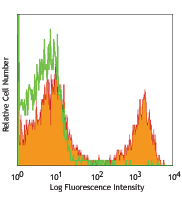- Clone
- Poly4064 (See other available formats)
- Regulatory Status
- RUO
- Isotype
- Donkey Polyclonal Ig
- Ave. Rating
- Submit a Review
- Product Citations
- publications

-

C57BL/6 splenocytes were stained with NK-1.1 APC and purified rabbit anti-Asialo-GM1, followed by donkey anti-rabbit IgG (clone Poly4064) PE (top image).
| Cat # | Size | Price | Quantity Check Availability | Save | ||
|---|---|---|---|---|---|---|
| 406421 | 100 µg | £72 | ||||
This polyclonal donkey anti-rabbit IgG antibody reacts with the heavy chains of rabbit IgG and with the light chains common to most rabbit immunoglobulins. No cross-reactivity has been detected against non-immunoglobulin serum proteins. This antibody has been solid-phase absorbed to ensure minimal cross-reaction with rat, human, bovine, horse, and mouse immunoglobulins, but it may cross-react with other subclasses of rabbit immunoglobulins.
Product DetailsProduct Details
- Reactivity
- Rabbit
- Antibody Type
- Polyclonal
- Host Species
- Donkey
- Formulation
- Phosphate-buffered solution, pH 7.2, containing 0.09% sodium azide.
- Preparation
- The antibody was purified by affinity chromatography and conjugated with PE under optimal conditions.
- Concentration
- 0.2 mg/ml
- Storage & Handling
- The antibody solution should be stored undiluted between 2°C and 8°C, and protected from prolonged exposure to light. Do not freeze.
- Application
-
FC - Quality tested
- Recommended Usage
-
Each lot of this antibody is quality control tested by immunofluorescent staining with flow cytometric analysis. For flow cytometric staining, the suggested use of this reagent is ≤0.125 µg per million cells in 100 µl volume. It is recommended that the reagent be titrated for optimal performance for each application.
- Excitation Laser
-
Blue Laser (488 nm)
Green Laser (532 nm)/Yellow-Green Laser (561 nm)
- Application Notes
-
This conjugated polyclonal donkey anti-rabbit IgG antibody is useful for immunofluorescent staining for flow cytometry, or microscopy.
- Product Citations
- RRID
-
AB_2563484 (BioLegend Cat. No. 406421)
Related Pages & Pathways
Pages
Related FAQs
- What type of PE do you use in your conjugates?
- We use R-PE in our conjugates.
Customers Also Purchased
Compare Data Across All Formats
This data display is provided for general comparisons between formats.
Your actual data may vary due to variations in samples, target cells, instruments and their settings, staining conditions, and other factors.
If you need assistance with selecting the best format contact our expert technical support team.
 Login / Register
Login / Register 
















Follow Us